Are you looking for inspiration on what to do with your PowerBlocks? Maybe you’re looking to buy a pair but don’t know how to use them? Then stick around! Below, I share a full-body PowerBlock dumbbell home workout as well as a complete list of exercises you can do with PowerBlocks.
PowerBlocks can be used to perform all dumbbell exercises including compound and isolation movements. Despite their unconventional shape, they are versatile free weights that function just like any other dumbbell. They are great for building muscle, burning fat, and increasing muscle tone.
I’ve used the PowerBlock Elites to help me transform a skinny frame into an athletic physique.
And this post reveals exactly how I did it!
The workout is based on the PowerBlock Elite, but it can also be used with the Sports and Pros.
Let’s POWER through (get it?).
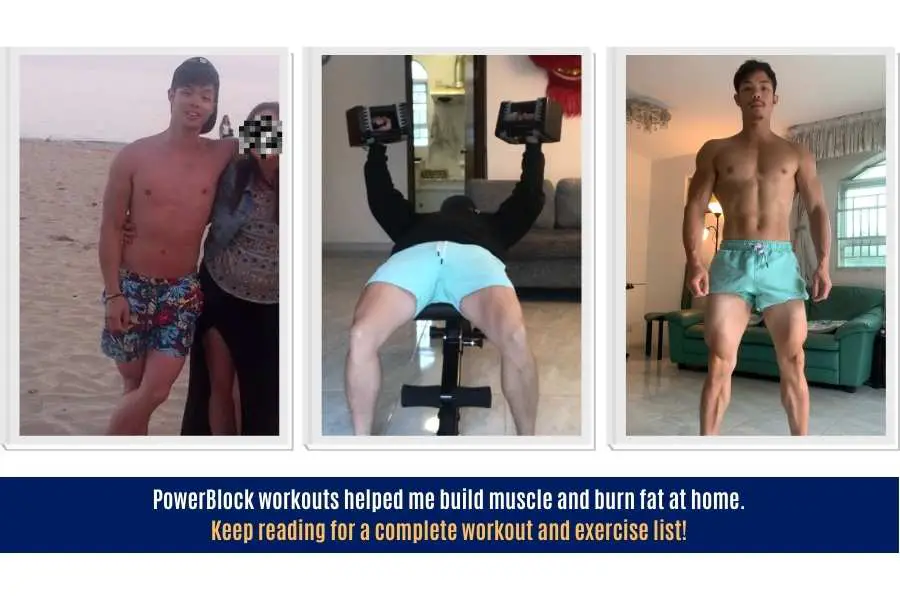
- Recommended Gear For This PowerBlock Workout
- A List Of PowerBlock Dumbbell Exercises You Can Do
- Can PowerBlocks Be Used To Do All Dumbbell Exercises?
- Full-Body PowerBlock Dumbbell Workout Program
- How To Do Each Exercise In This PowerBlock Dumbbell Workout
- 1) Flat Bench Press
- 2) Incline Bench Press
- 3) Close-Grip Bench Press
- 4) Overhand Bent-Over Row
- 5) Underhand Bent-Over Row
- 6) Bent-Over Hammer Row
- 7) Overhead Shoulder Press
- 8) Lateral Raise
- 9) Hammer Press
- 10) Decline Dumbbell Sit-Ups
- 11) Russian Twist
- 12) Dumbbell side-bend
- 13) Deadlift With Dumbbells
- 14) Goblet Squat
- 15) Bulgarian Split Squat
- 16) Hammer Curl
- 17) Overhead Tricep Extension
- 18) Bicep Curl
- Why This PowerBlock Dumbbell Workout Is Effective
- How To Progress With This PowerBlock Workout
- Equipment Used In This Workout
- Conclusion
Recommended Gear For This PowerBlock Workout
| Product | Brand | Description | Prime | Buy |
|---|---|---|---|---|
 Top
Top
Top Top
Top
Top | PowerBlock Elite EXP | BEST PowerBlock model adjustable from 2.5-90lbs in 2.5/5lb increments. Replaces up to 28 pairs of dumbbells. Requires addon kits for full weight settings. | PrimeEligible | Check Amazon Price |
Top Top
Top
Top Top
Top
Top | PowerBlock EXP | UPDATED BEST PowerBlock model adjustable from 2.5-90lbs in 2.5/5lb increments. Replaces up to 28 pairs of dumbbells. Same specs and function as the above PowerBlock Elite EXP but cheaper and newer. | PrimeEligible | Check Amazon Price |
 Top
Top
Top Top
Top
Top | PowerBlock Pro 50 | PREMIUM PowerBlock model adjustable from 2.5-50lbs in 2.5/5lb increments. Replaces 14 pairs of dumbbells. Features urethane-coating but not expandable past 50lbs. | PrimeEligible | Check Amazon Price |
 Top
Top
Top Top
Top
Top | PowerBlock Sport 24 | BUDGET PowerBlock model adjustable from 3-24lbs in 3lb increments. Replaces 8 pairs of dumbbells. | PrimeEligible | Check Amazon Price |
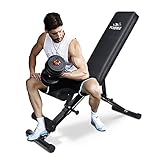 Top
Top
Top Top
Top
Top | Flybird | Foldable weight bench that can be adjusted with flat, incline, and decline settings. Good-value weight bench for the PowerBlock dumbbells. | PrimeEligible | Check Amazon Price |
 | Undersun | Heavy-duty resistance bands. Cost-effective way to increase resistance on dumbbells which have a limited amount of weight. | Prime | Check Amazon Price |
This full-body dumbbell workout has been designed around the PowerBlock dumbbells.
It doesn’t matter which model you have because all PowerBlocks work the same way and are therefore used in the same manner.
With that said, here’s the list of equipment I currently use and recommend for this workout:

- PowerBlocks (required). You’ll obviously need a pair of PowerBlock dumbbells for this workout! The PowerBlock Elite, Sports, and Pro series are all very good. Those looking to build muscle should go with the heavier models (50lbs+). Those looking to burn fat and tone can go with a light-moderate model (24-50lbs). In my opinon, the PowerBlock Elites (link for my hands-on review) offer the best value for a beginner-intermediate.
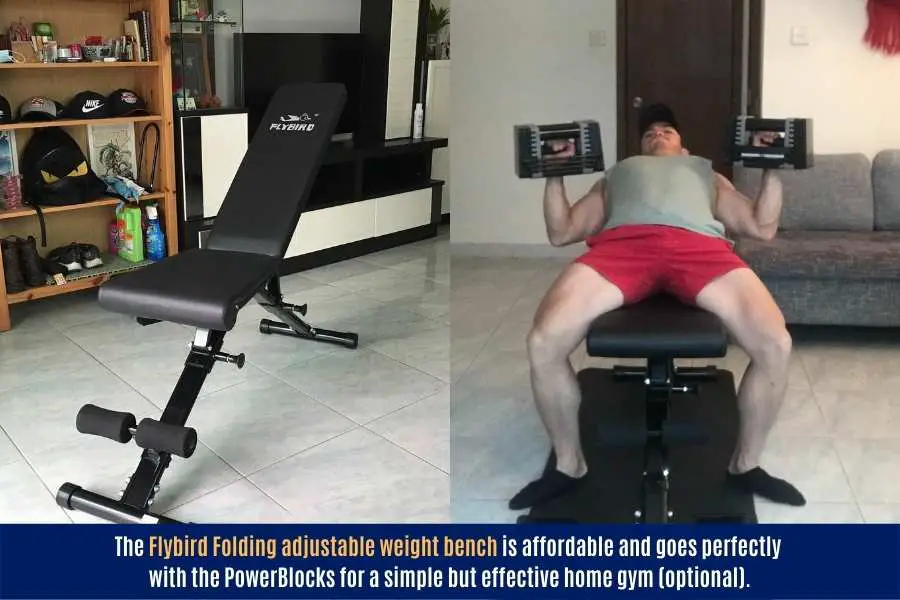
- Flybird folding adjustable weight bench (optional). An FID (flat/incline/decline) bench isn’t essential for this workout. After all you can always swap the bench for the floor. But a bench allows you to capitalize on incline and decline angles to target specific regions of your body. A bench also gives you a full range of motion in your movements and allows you to lift heavier weights. This is important for gaining the full benefits from each exercise. You don’t have to buy the expensive PowerBlock bench. I use the affordable Flybird (link for hands-on review) and it does the job perfectly well!
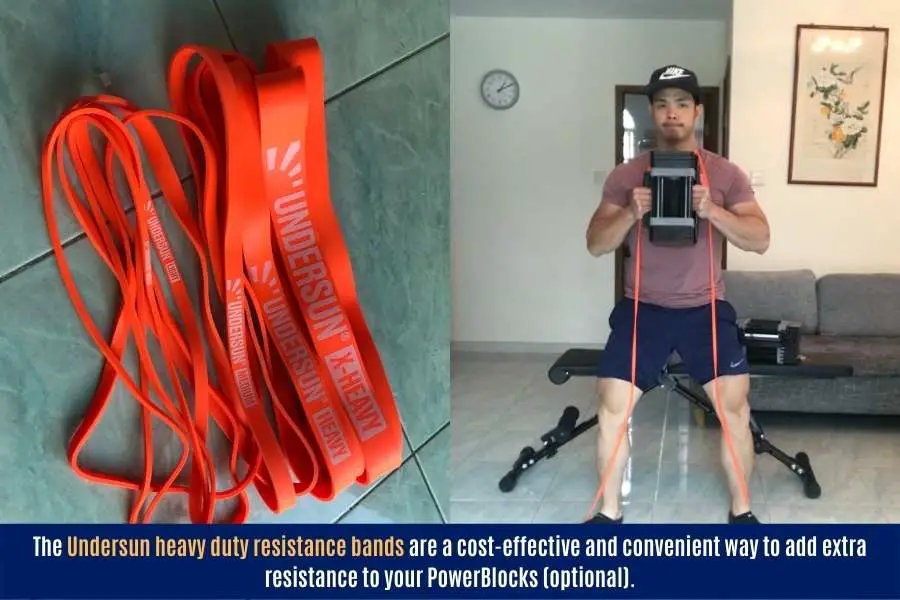
- Undersun heavy-duty resistance bands (optional). Lower body exercises are inherently limited by the weight of the dumbbell (which don’t go very high relative to how big your leg muscles are). I’m talking about movements like the squat and deadlift. You may quickly outgrow your PowerBlocks if you’re progressive overloading regularly. This isn’t a PowerBlock-specific limitation but a drawback with all dumbbells. I like to use heavy resistance bands like these Undersuns (you can find my full opinions here) to add extra resistance in a convenient and cost-effective manner!
Not sure which PowerBlock is right for you? You can check out my other post to learn more about the different PowerBlock models and which is the best!
A List Of PowerBlock Dumbbell Exercises You Can Do
I’ve categorized a selection of PowerBlock movements into the different muscle groups they target.
Here’s a comprehensive list of different exercises you can do with a PowerBlock dumbbell.
- Arm exercises you can do with PowerBlocks:
| Arm Exercise | Movement Type | Primary Target Muscles | Equipment Required |
|---|---|---|---|
| Traditional bicep curl | Isolation | Biceps brachii short head, brachialis, brachioradialis | Dumbbell-only |
| Reverse-grip curl | Isolation | Brachioradialis | Dumbbell-only |
| Hammer curl | Isolation | Biceps brachii long head, brachialis | Dumbbell-only |
| Incline curl | Isolation | Biceps brachii long head, brachialis, brachioradialis | Bench + dumbbell |
| Spider curl | Isolation | Biceps brachii long and short heads | Bench + dumbbell |
| Concentration curl | Isolation | Biceps brachii long and short heads | Bench + dumbbell |
| Overhead tricep extension | Isolation | Triceps long head | Dumbbell-only |
| Tricep kickback | Isolation | Triceps long head | Bench + dumbbell |
| Skullcrushers | Isolation | Triceps long head | Bench + dumbbell |
| Close-grip bench press | Compound | Triceps medial and lateral head | Bench + dumbbell |
| Diamond-grip dumbbell push up | Compound | Triceps medial and lateral head | Dumbbell-only |
- Chest exericses you can do with PowerBlocks:
| Chest Exercise | Movement Type | Primary Target Muscles | Equipment Required |
|---|---|---|---|
| Flat bench press | Compound | Pectoralis major, pectoralis minor, anterior deltoids | Bench + dumbbell |
| Incline bench press | Compound | Upper pectorals | Bench + dumbbell |
| Decline bench press | Compound | Lower pectorals | Bench + dumbbell |
| Flat dumbbell fly | Isolation | Pectoralis major, pectoralis minor | Bench + dumbbell |
| Incline dumbbell fly | Isolation | Upper pectorals | Bench + dumbbell |
| Decline dumbbell fly | Isolation | Lower pectorals | Bench + dumbbell |
| Close-grip bench press | Compound | Pectorals, triceps | Bench + dumbbell |
| Dumbbell pull-over | Compound | Pectorals, anterior deltoids, latissimus dorsi | Bench + dumbbell |
| Dumbbell push-up | Compound | Pectoralis major, pectoralis minor, anterior deltoids | Dumbbell-only |
- Shoulder exercises you can do with PowerBlocks:
| Shoulder Exercise | Movement Type | Primary Target Muscles | Equipment Required |
|---|---|---|---|
| Overhead shoulder press | Compound | Anterior deltoids, medial deltoids, posterior deltoids, triceps | Bench + dumbbell |
| Hammer press | Compound | Anterior deltoids, medial deltoids, posterior deltoids, triceps | Bench + dumbbell |
| Lateral raise | Isolation | Medial deltoids | Dumbbell-only |
| Front raise | Isolation | Anterior deltoids | Dumbbell-only |
| Incline reverse fly on a bench | Isolation | Posterior deltoids | Bench + dumbbell |
| Shrugs | Isolation | Trapezius | Dumbbell-only |
| Arnold press | Compound | Anterior deltoids, medial deltoids, posterior deltoids, triceps, biceps | Bench + dumbbell |
| Upright row | Compound | Medial deltoids, biceps | Dumbbell-only |
- Back exercises you can do with PowerBlocks:
| Back Exercise | Movement Type | Primary Target Muscles | Equipment Required |
|---|---|---|---|
| Overhand bent-over row | Compound | Trapezius, rhomboids, latissimus dorsi | Dumbbell-only |
| Underhand bent-over row | Compound | Trapezius, rhomboids, latissimus dorsi, biceps | Dumbbell-only |
| Narrow-grip bent-over row | Compound | Rhomboids, latissimus dorsi, biceps | Dumbbell-only |
| Bent-over hammer row | Compound | Rhomboids, latissimus dorsi, biceps | Dumbbell-only |
| Reverse fly | Isolation | Rhomboids, posterior deltoids | Dumbbell-only |
| Incline reverse fly on a bench | Isolation | Trapezius, posterior deltoids | Bench + dumbbell |
| Renegade row | Compound | Trapezius, rhomboids, latissimus dorsi, deltoids, biceps, core, glutes | Dumbbell-only |
| Dumbbell-weighted pull-ups | Compound | Trapezius, rhomboids, latissimus dorsi, biceps, core | Power tower + dumbbell |
| Shrugs | Isolation | Trapezius | Dumbbell-only |
- Abdominal exercises you can do with PowerBlocks:
| Ab Exercise | Movement Type | Primary Target Muscles | Equipment Required |
|---|---|---|---|
| Dumbbell crunch | Isolation | Abdominals, obliques | Dumbbell-only |
| Decline dumbbell sit up | Isolation | Abdominals, obliques | |
| Kneeling woodchopper | Isolation | Abdominals, obliques | Dumbbell-only |
| Hanging leg raise | Isolation | Lower abdominals | Power tower + dumbbell |
| Lying leg raise | Isolation | Lower abdominals | Dumbbell-only |
| Dumbbell plank | Compound | Full-body with emphasis on core | Dumbbell-only |
| Russian twist | Isolation | Abdominals, obliques | Dumbbell-only |
| Dumbbell side bend | Isolation | Obliques | Dumbbell-only |
- Leg exercises you can do with PowerBlocks:
| Leg Exercise | Movement Type | Primary Target Muscles | Equipment Required |
|---|---|---|---|
| Shoulder front squat | Compound | Quadriceps, hamstrings, calves, glutes, deltoids | Dumbbell-only |
| Dumbbell squat | Compound | Quadriceps, hamstrings, calves, glutes, deltoids | Dumbbell-only |
| Goblet squat | Compound | Quadriceps, hamstrings, calves, glutes | Dumbbell-only |
| Bulgarian split squat | Compound | Quadriceps, hamstrings, calves, glutes | Bench + dumbbell |
| Sumo pile squat | Compound | Emphasis on hamstrings and glutes | Dumbbell-only |
| Deadlift with dumbbells | Compound | Full-body | Dumbbell-only |
| Romanian deadlift | Compound | Emphasis on hamstrings and glutes | Dumbbell-only |
| Lunge | Compound | Quadriceps, hamstrings, calves, glutes | Dumbbell-only |
| Farmers walk | Compound | Quadriceps, hamstrings, calves, glutes, deltoids | Dumbbell-only |
Can PowerBlocks Be Used To Do All Dumbbell Exercises?
Yup!
Powerblocks can be used to do all of the most popular exercises, as well as the more unorthodox movements.
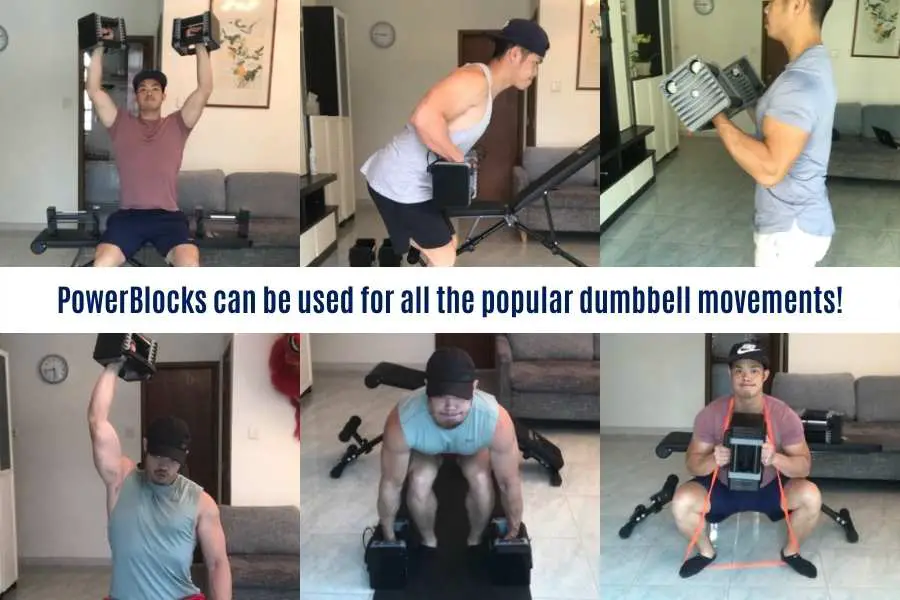
Examples of popular movements include:
- Presses.
- Rows.
- Curls.
- Extensions.
- Squats.
- Deadlifts.
These types of exercises require you to grip the PowerBlock on the handle, just like any other dumbbell.
You’ll need an adjustable weight bench to fully capitalize on all of these movements. For example, exercise variations like the incline bench press and split squat can only be performed safely using a bench.
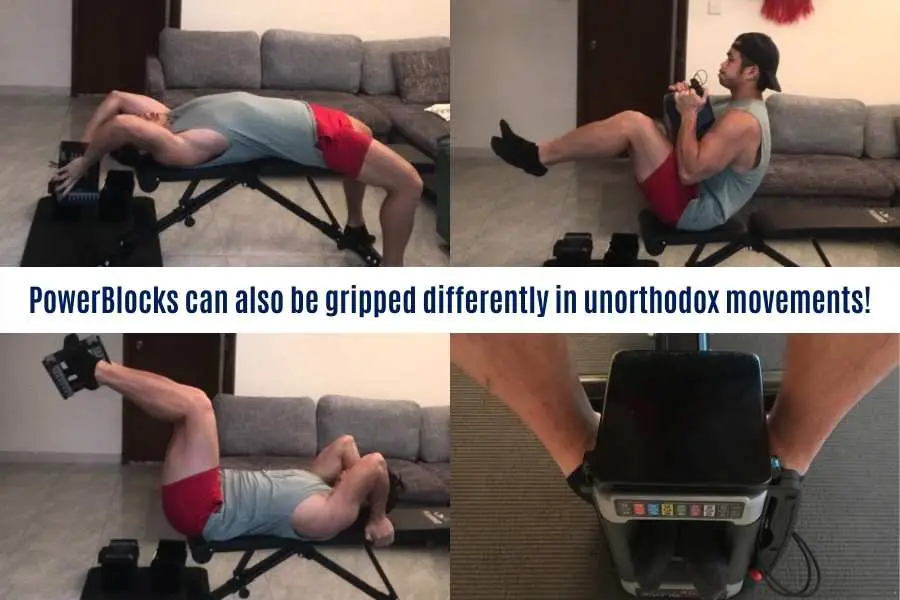
Examples of unorthodox (not so popular) movements include:
- Dumbbell pull-overs.
- Leg-raises.
- Crunches.
- Dumbbell pull-ups.
These types of exercises require you to grip the dumbbell outside the handle. This may be awkward with the PowerBlocks since they don’t have a conventional dumbbell shape.
But it’s still possible to use trial and error to adjust and find a grip that’s safe and comfortable to do these movements with.
Next, I’ll show you how to combine the PowerBlock exercises into a full-body routine to build muscle and burn fat at home!
Confused about which PowerBlock is best for you? You can check out my other article to find out how much each PowerBlock weighs and which are expandable!
Full-Body PowerBlock Dumbbell Workout Program
This full-body home exercise routine is suitable for anyone with a pair of PowerBlocks.
It can be performed by beginners and intermediate lifters alike (increase weight according to your own fitness levels).
I used this PowerBlock dumbbell workout to build lean muscle and tone. But it can also be used to burn fat if you keep your calorie intake low.
The program consists of a 3-day full-body home training split as follows:
| Training Day | Workout |
|---|---|
| 1 | Full-body |
| 2 | Rest |
| 3 | Full-body |
| 4 | Rest |
| 5 | Full-body |
| 6 | Rest |
| 7 | Rest |
You’ll work the entire body on each training day. And each workout is separated by at least 24 hours of rest as recommended by ACSM (American College of Sports Medicine).
It doesn’t matter which days you train.
What’s important is to space your workouts such that your body gets a full 24-48 hours of recovery before being hit by the next session.
The exercises chosen for this program have been cherry-picked from the PowerBlock workout app and poster.
Each workout takes approximately 1-1.5 hours to complete depending on your rest time between sets.
Day 1 PowerBlock full-body dumbbell workout:
| PowerBlock Exercise | Sets | Reps | Rest Between Sets | Weight |
|---|---|---|---|---|
| Flat bench press | 4 | 8-12 | 1-3 mins | ~80% of 1RM |
| Overhand bent-over row | 4 | 8-12 | 1-3 mins | ~80% of 1RM |
| Overhead shoulder press | 4 | 8-10 | 1-3 mins | ~80% of 1RM |
| Decline dumbbell sit-ups | 4 | 10-15 | 1-3 mins | ~60% of 1RM |
| Goblet Squat | 4 | 10-15 | 1-3 mins | ~60% of 1RM |
| Hammer curl | 4 | 10-15 | 1-3 mins | ~60% of 1RM |
Day 2 PowerBlock full-body dumbbell workout:
| PowerBlock Exercise | Sets | Reps | Rest Between Sets | Weight |
|---|---|---|---|---|
| Incline bench press | 4 | 8-12 | 1-3 mins | ~80% of 1RM |
| Underhand bent-over row | 4 | 8-12 | 1-3 mins | ~80% of 1RM |
| Lateral raise | 4 | 10-15 | 1-3 mins | ~60% of 1RM |
| Russian twist | 4 | 10-15 | 1-3 mins | ~60% of 1RM |
| Deadlift with dumbbells | 4 | 10-15 | 1-3 mins | ~60% of 1RM |
| Overhead tricep extension | 4 | 10-15 | 1-3 mins | ~60% of 1RM |
Day 3 PowerBlock full-body dumbbell workout:
| PowerBlock Exercise | Sets | Reps | Rest Between Sets | Weight |
|---|---|---|---|---|
| Close-grip bench press | 4 | 8-12 | 1-3 mins | ~80% of 1RM |
| Bent-over hammer row | 4 | 8-12 | 1-3 mins | ~80% of 1RM |
| Hammer press | 4 | 8-10 | 1-3 mins | ~80% of 1RM |
| Dumbbell side bend | 4 | 10-15 | 1-3 mins | ~60% of 1RM |
| Bulgarian split squat | 4 | 8-12 | 1-3 mins | ~80% of 1RM |
| Bicep curl | 4 | 10-15 | 1-3 mins | ~60% of 1RM |
How To Do Each Exercise In This PowerBlock Dumbbell Workout
Below, you’ll find a guide on how to do each dumbbell exercise in this PowerBlock workout routine.
1) Flat Bench Press
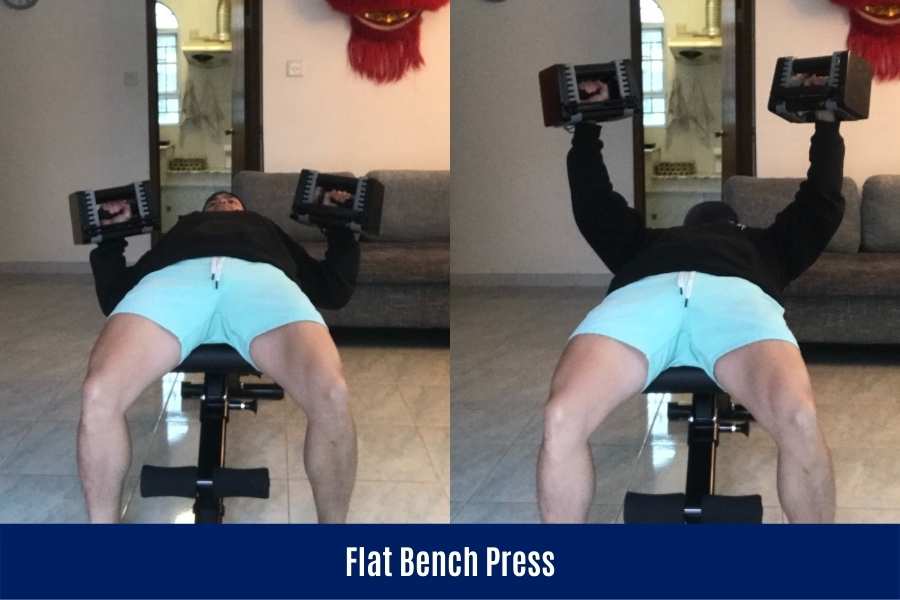
Recommended Beginners Weight:
25lbs/10lbs (men/women, per PowerBlock).
What It’s Good For:
Overall chest builder that also improves your functional pushing strength!
Top Tip:
On the very last set, do AMRAP (as many reps as possible) of push-ups on PowerBlocks. This will be hard but it’s a great way to really fatigue the chest, burn calories, and get a huge pump!
2) Incline Bench Press
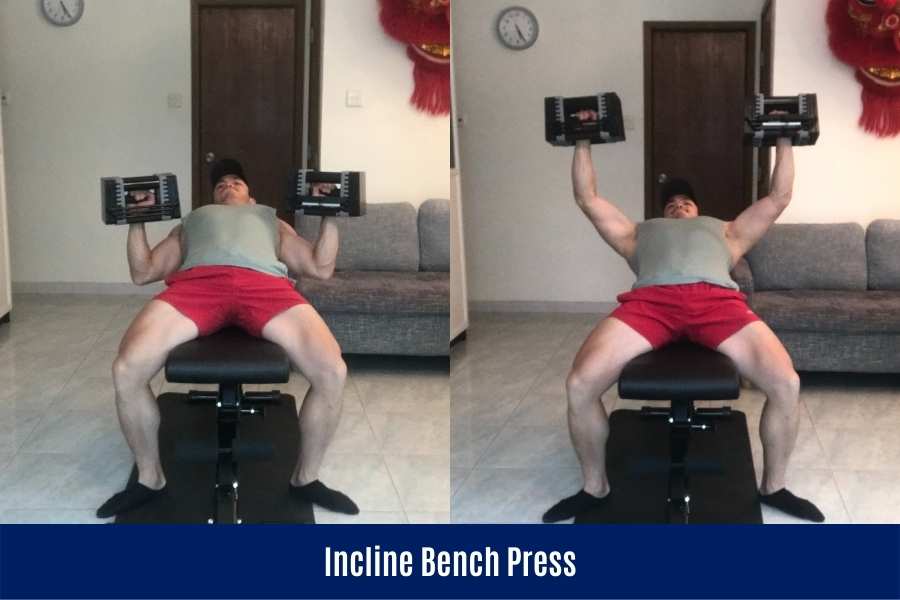
Recommended Beginners Weight:
25lbs/10lbs (men/women, per PowerBlock).
What It’s Good For:
Emphasizes the upper pectorals for balanced chest development and volume.
Top Tip:
Keep your elbows tucked in rather than flared out. Most people find this to be more comfortable and it also reduces the likelihood of shoulder pain/injury due to internal rotation. Additionally, studies have shown that a 30° incline is the best for activating the upper pecs!
3) Close-Grip Bench Press
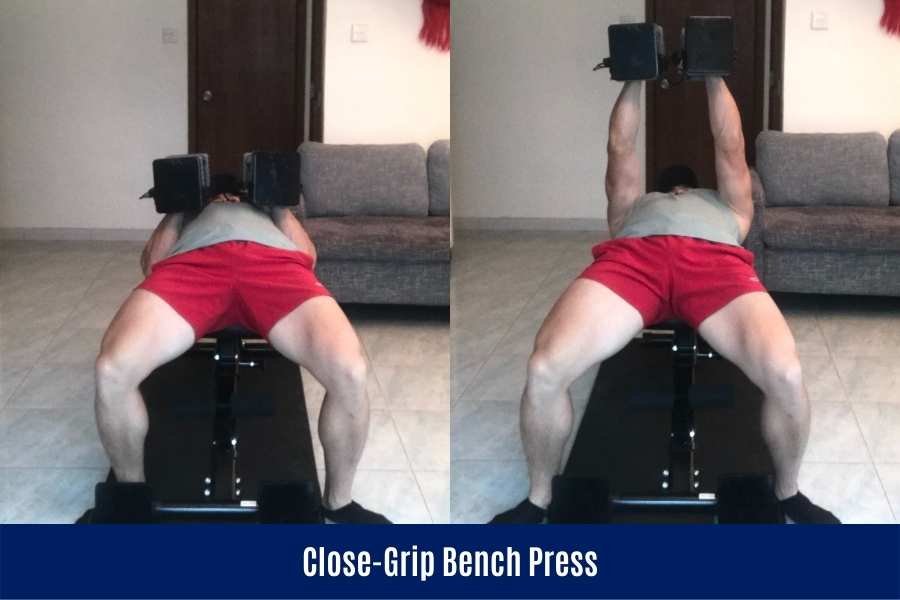
Recommended Beginners Weight:
25lbs/10lbs (men/women, per PowerBlock).
What It’s Good For:
Works the chest but also shifts a lot of emphasis onto the triceps for well-defined arms!
Top Tip:
It can be tempting to push with just the arms. But remember this is predominantly a chest exercise. Focus on pushing the PowerBlock upwards by contracting your chest. This will give you the full benefits of this exercise.
You’ll need a weight bench like this Flybird to do any kind of bench press!
4) Overhand Bent-Over Row

Recommended Beginners Weight:
20lbs/10lbs (men/women, per PowerBlock).
What It’s Good For:
An all-round back exercise that will help you build a solid v-shaped body. It’s the pulling equivalent to the bench press.
Top Tip:
To activate all your back muscles evenly- bend your knees slightly, make sure your back is leaned forward at an approximately 45° angle from the floor, and pull the PowerBlock towards your navel (belly-button).
5) Underhand Bent-Over Row
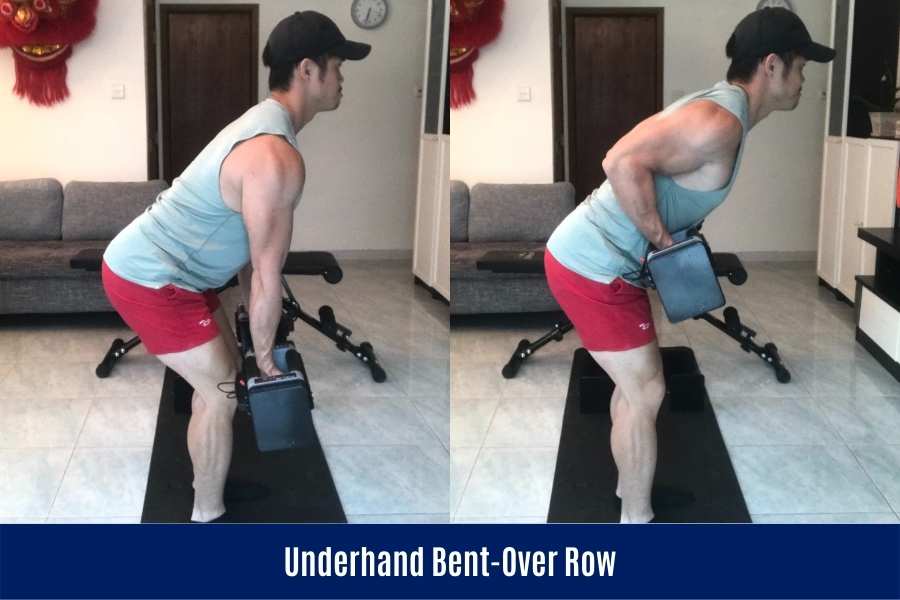
Recommended Beginners Weight:
20lbs/10lbs (men/women, per PowerBlock).
What It’s Good For:
Similar to the overhand bent-over row but shifts emphasis onto greater biceps activation!
Top Tip:
Let the PowerBlocks go all the way down (to the point they can no longer go any further) before pulling them back up. This is called a full range of motion (ROM). It ensures full activation of your lats, traps, rhomboids, AND biceps.
6) Bent-Over Hammer Row
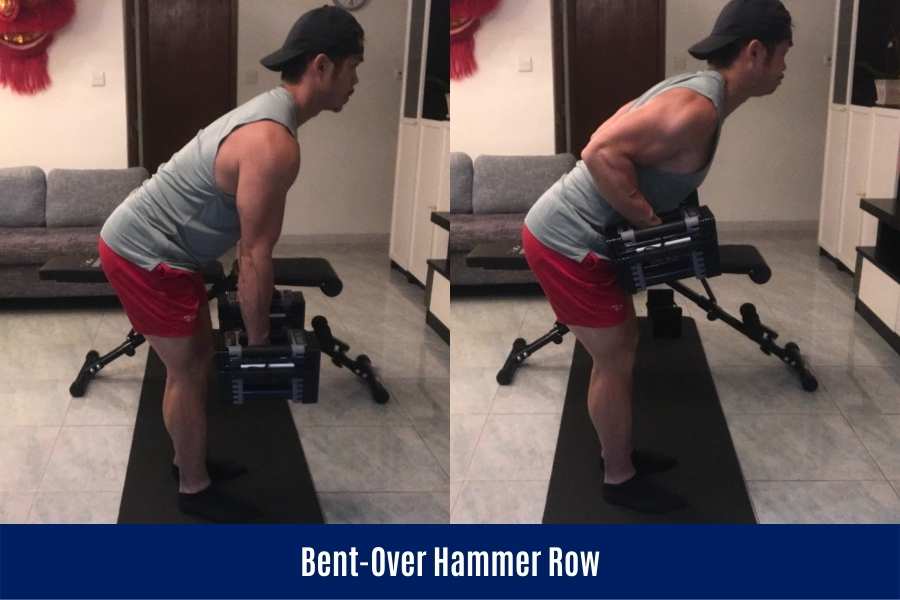
Recommended Beginners Weight:
20lbs/10lbs (men/women, per PowerBlock).
What It’s Good For:
A variation of the bent-over row that shifts the emphasis onto the latissimus dorsi (“lats”) for a strong V-tapered flare!
Top Tip:
The PowerBlocks should drop all the way down to achieve a full ROM and maximize lat activation.
7) Overhead Shoulder Press
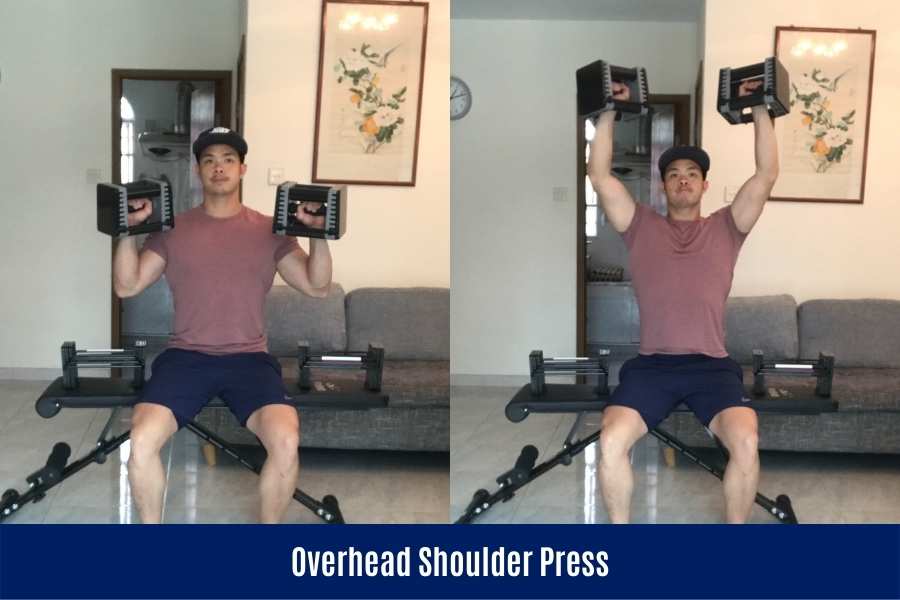
Recommended Beginners Weight:
20lbs/7.5lbs (men/women, per PowerBlock).
What It’s Good For:
THE absolute best exercise for general shoulder development and toning.
Top Tip:
Keep the movement compact. Do this by keeping your elbows tucked towards the torso and the PowerBlocks stacked on top of your elbows. This helps you shift heavier weights whilst also reducing the likelihood of shoulder pain.
8) Lateral Raise
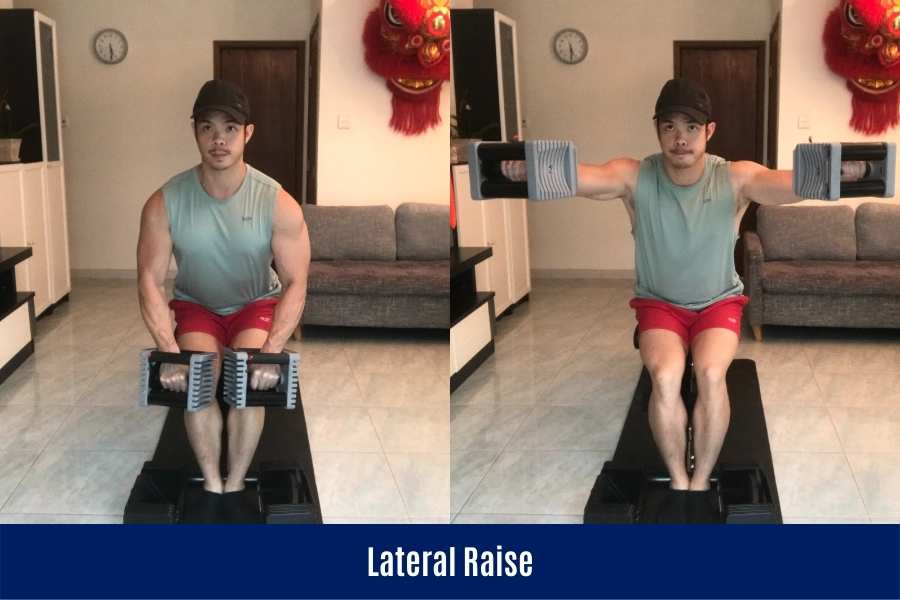
Recommended Beginners Weight:
5lbs/2.5lbs (men/women, per PowerBlock).
What It’s Good For:
Targets the side shoulders. Performed using a light weight, it will tone and define the deltoids. Performed using a heavy weight and it will help you build “shoulder boulders”!
Top Tip:
Sit on a bench and lean slightly forwards. The PowerBlocks should travel upwards and slightly forwards rather than directly to your sides. This helps to localize tension directly onto the shoulders.
9) Hammer Press
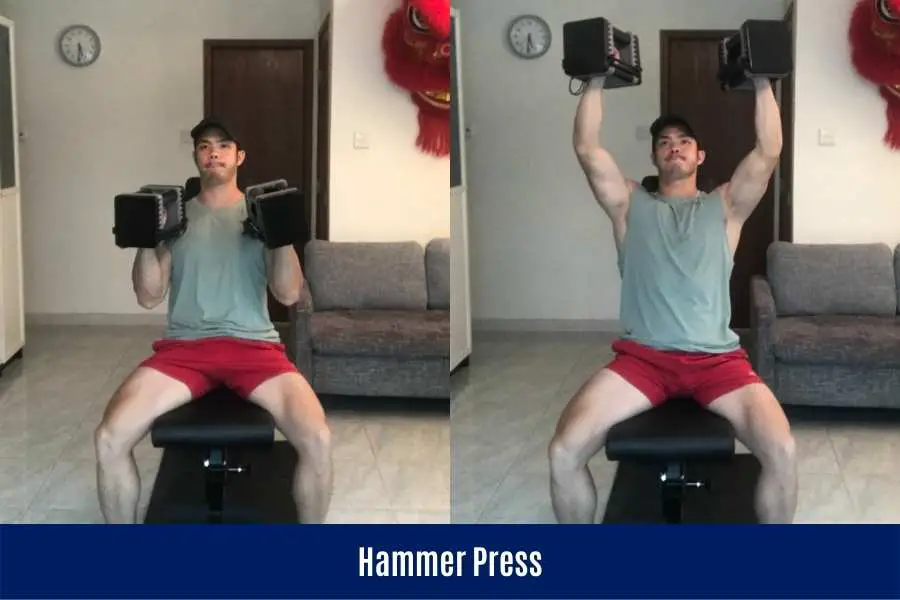
Recommended Beginners Weight:
20lbs/7.5lbs (men/women, per PowerBlock).
What It’s Good For:
Shifts emphasis onto the anterior deltoids for more pronounced front shoulders!
Top Tip:
Vary the distance between the PowerBlocks to target different regions of your shoulders. Widening the distance emphasizes the side shoulders whilst narrowing the distance emphasizes the front shoulders.
10) Decline Dumbbell Sit-Ups

Recommended Beginners Weight:
None (master bodyweight first before adding 5lb increments).
What It’s Good For:
A classic ab-builder to help those six-pack abs pop out (assuming you also have a low body fat percentage)! The decline puts you in a deficit position to make the movement much harder.
Top Tip:
Practice bodyweight ab crunches first before holding a PowerBlock against your chest. Once this is comfortable, you can move onto the decline dumbbell sit-up to really hit your core and build tone in your abdominal region.
You’ll need a declining weight bench like the Flybird to do this exercise.
11) Russian Twist
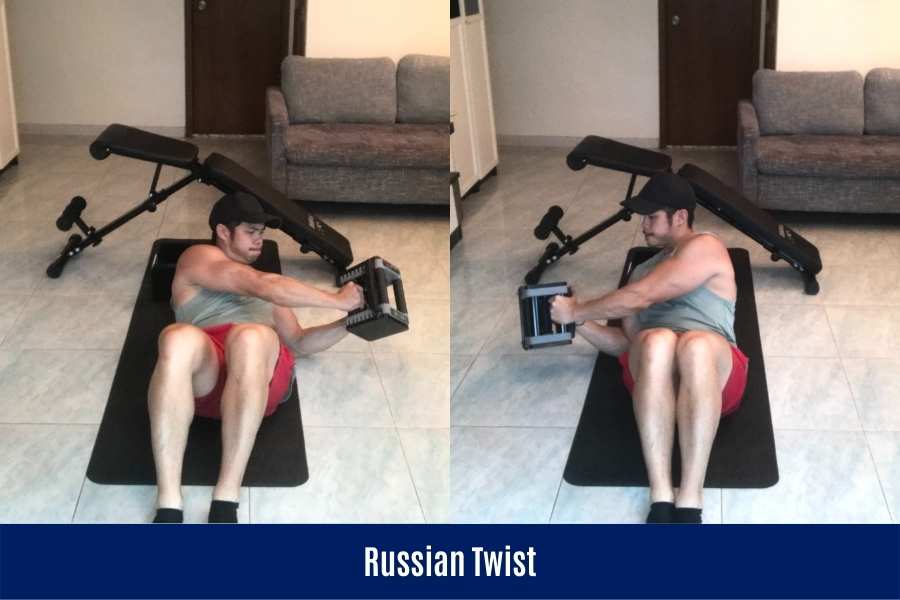
Recommended Beginners Weight:
None (master bodyweight first before adding 5lb increments).
What It’s Good For:
Hits the six-pack abdominals and the obliques at the same time for a shredded core!
Top Tip:
It can be hard to maintain balance during this exercise. So practice this movement without a dumbbell first. Once you’ve nailed the bodyweight version, you can hold a PowerBlock dumbbell between both hands to increase intensity.
12) Dumbbell side-bend
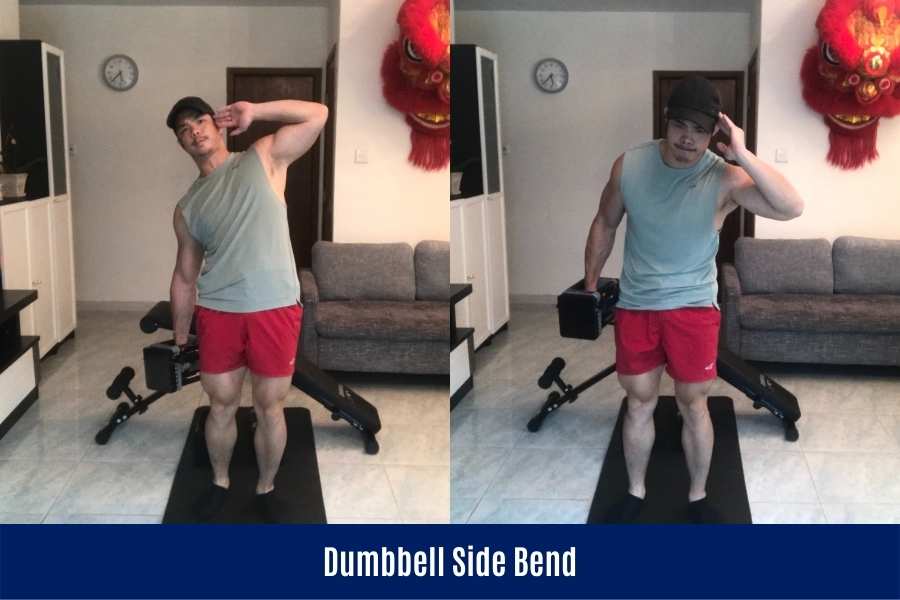
Recommended Beginners Weight:
10lbs/5lbs (men/women, per PowerBlock).
What It’s Good For:
Isolates the external and internal obliques which can help you develop V-cut abs.
Top Tip:
For maximum effect, you should “bend” in the horizontal and vertical plane, not just the horizontal plane. In other words, your torso should move front and back as well as side to side as you go through the movement. A common mistake is to just bend strictly in a side-to-side motion.
13) Deadlift With Dumbbells
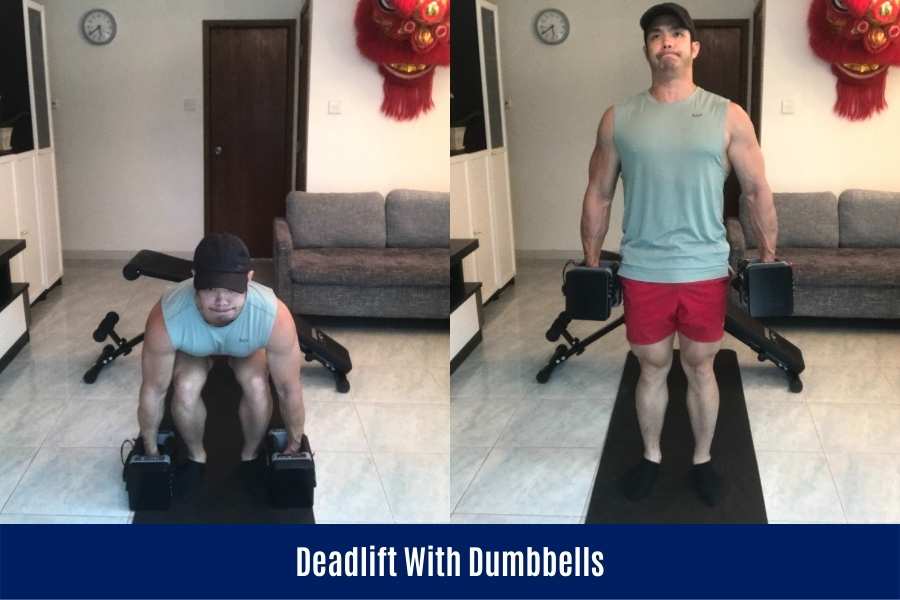
Recommended Beginners Weight:
25lbs/10lbs (men/women, per PowerBlock).
What It’s Good For:
Classic total-body strength and muscle exercise that can also torch calories and burn fat!
Top Tip:
Deadlifts can be awkward with PowerBlock dumbbells because your feet can’t slide under the handle like in regular dumbbells/barbells. Have them next to your feet instead!
14) Goblet Squat
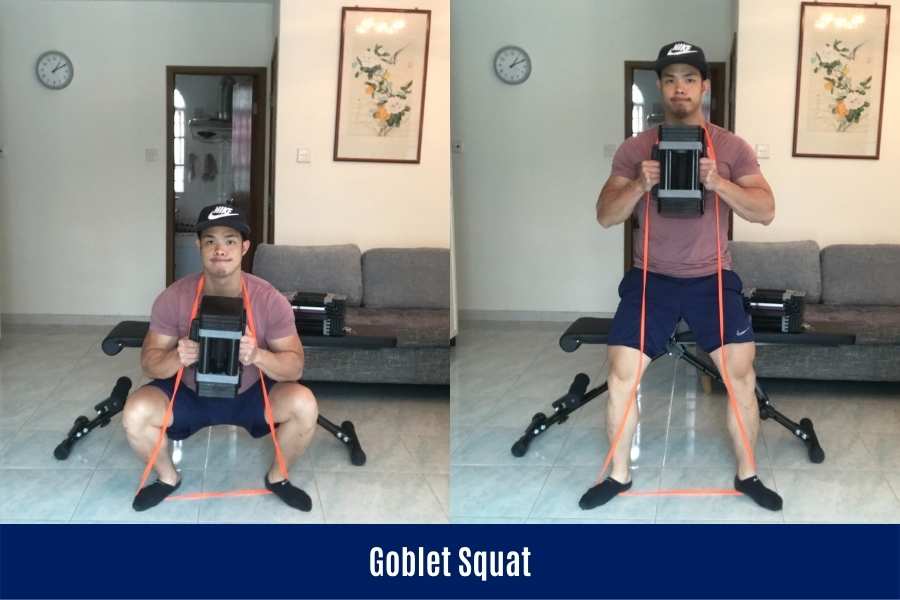
Recommended Beginners Weight:
20lbs/15lbs (men/women, per PowerBlock).
What It’s Good For:
A beginner-friendly squat variation that will build lower body muscle as well as torch calories and burn fat!
Top Tip:
Most people will outgrow their PowerBlocks (and most dumbbells for that matter) in no time since the legs are the largest muscles in your body, and you’re only lifting one dumbbell. I like to use heavy resistance bands like the Undersuns to add extra resistance conveniently and cost-effectively!
15) Bulgarian Split Squat
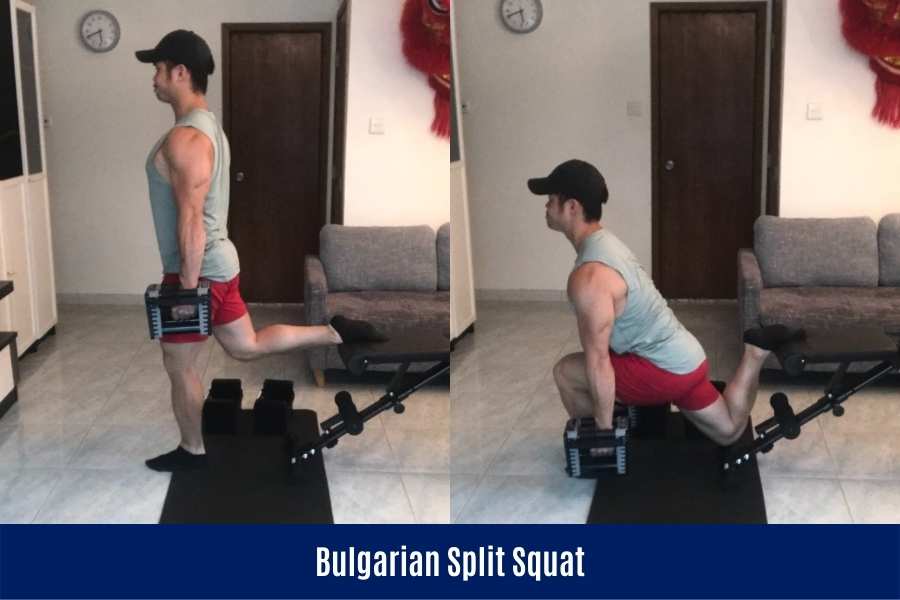
Recommended Beginners Weight:
25lbs/20lbs (men/women, per PowerBlock).
What It’s Good For:
This is much harder than a conventional dumbbell squat because you’re pushing with one leg. This effectively doubles your PowerBlock weight. It’s great for building the quads, hamstrings, and glutes, as well as burning calories and fat.
Top Tip:
Your leading foot should be centered right in the middle of the 2 Powerblocks in each hand. Also fixating your gaze on a distant object. This helps you maintain balance as you go through the movement.
16) Hammer Curl

Recommended Beginners Weight:
7.5lbs/2.5lbs (men/women, per PowerBlock).
What It’s Good For:
Targets the biceps short head which contributes to the biceps “peak” (or bulge)!
Top Tip:
Toning and building bigger arms is top of the agenda for a lot of people. And to do this, you need to include a variety of arm movements in your PowerBlock dumbbell workout. I recommend choosing 1-3 arm exercises at a time and cycling through the different movements every couple of months!
17) Overhead Tricep Extension
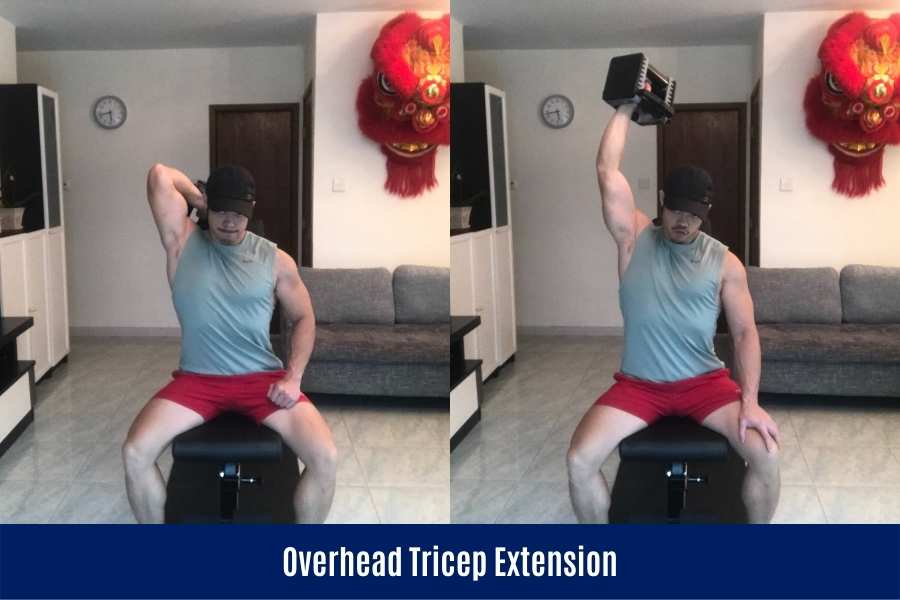
Recommended Beginners Weight:
7.5lbs/2.5lbs (men/women, per PowerBlock).
What It’s Good For:
Isolates all 3 triceps heads to give you toned and cut upper arms!
Top Tip:
Let the PowerBlock drop all the way down until it can touch your neck. This ensures you achieve the depth required to really stretch and activate the triceps.
18) Bicep Curl
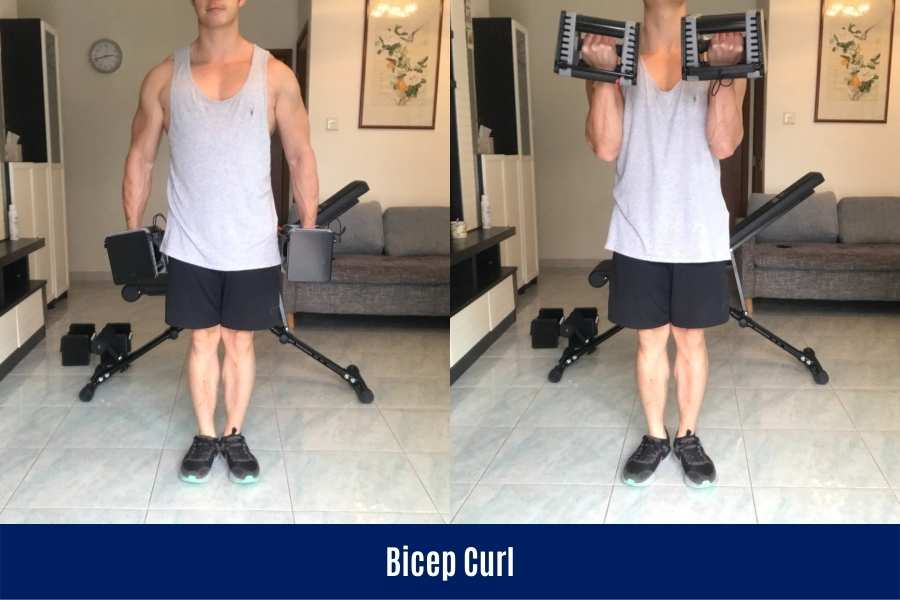
Recommended Beginners Weight:
7.5lbs/2.5lbs (men/women, per PowerBlock).
What It’s Good For:
Famous exercise that will target the biceps short head to build “thicker” looking biceps.
Top Tip:
Start the movement by gripping the PowerBlocks using a neutral grip (palms facing each other). As you curl the PowerBlock up, simultaneously rotate your wrists outwards. This leads to the best biceps activation. Wanna see how this works? Stick out your right fist and rotate it clockwise. You’ll see your biceps contract!
Interested in ordering PowerBlocks? You might want to check my other post which shares my experience on how long it takes PowerBlocks to deliver and how much shipping is.
Why This PowerBlock Dumbbell Workout Is Effective
Not many people enjoy working out 24/7 and I’m guessing that applies to you too!
This PowerBlock home dumbbell workout is based primarily on compound movements that activate multiple muscles in a single motion.
Not only does this give you more bang for your buck in terms of overall muscle gains, but it also means you’ll expend more calories if you’re goal is to burn fat and lose weight.
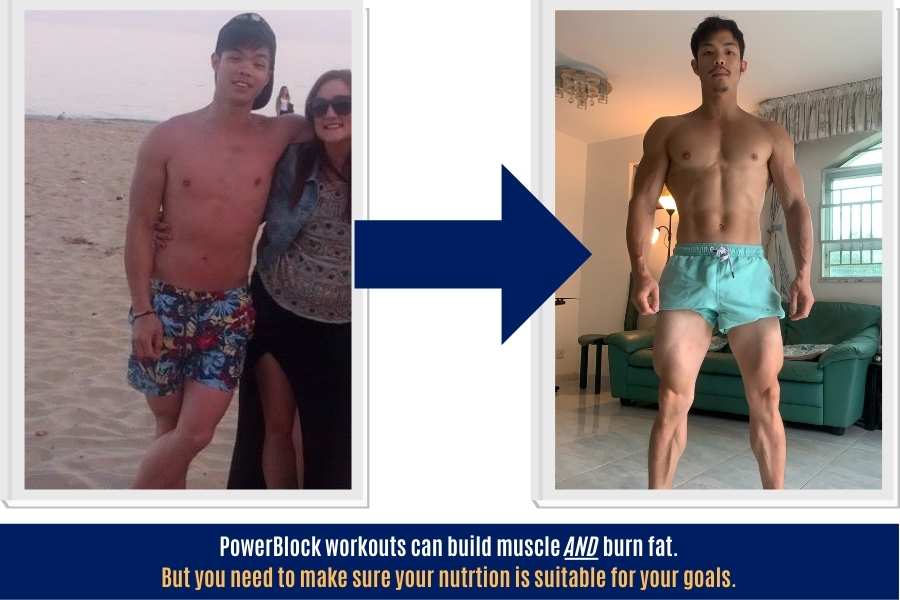
Note, this workout is just a guideline.
Feel free to include more isolation movements from my list of PowerBlock exercises should you wish.
These are great for building definition in specific muscles but aren’t so great for overall muscle-building/fat-burning.
This PowerBlock home workout is also volume-optimized.
This means you’re working each muscle with enough training volume (weight, reps, and sets per week) without running the risk of overtraining.
The 24-48 hour rest period between workouts is enough for most beginners to fully recover before the next session.
A word of nutrition advice…
Good nutrition is important for this PowerBlock workout to help you reach your goals.
If you’re trying to build muscle and tone, then stick to a mild 5-10% calorie surplus to lean bulk.
On the other hand, if you’re trying to lose weight and get ripped, then go with a 5% calorie deficit to cut.
Either way, you should eat around 1g of protein per lb of body weight per day.
Still unsure if the PowerBlocks give you good value for money? You can check out my other post to find out if PowerBlocks are worth it!
How To Progress With This PowerBlock Workout
I’ve given you approximate weight guidelines and starting weight recommendations.
But these are just guidelines for you to adjust according to your own strength.
You know you’ve chosen the perfect weight when each set is challenging enough to fatigue your target muscle but not so heavy that your form breaks down.
If you’re aiming to burn fat at home, then you can more or less stick to the same weight and control your nutrition (high-protein calorie deficit). Feel free to try out different exercises too.
But if you’re looking to build muscle at home, then you should apply progressive overload.
Overloading aims to increase exercise intensity as you become stronger.
As a result, you’ll keep your muscles challenged for growth.
You can apply progressive overload to your PowerBlock routine by increasing:
- Weight. Add 2.5-5lbs per PowerBlock to isolation exercises and 5-10lbs per PowerBlock to compound exercises. Do this whenever you feel you’re ready. Once every 1-3 weeks is a good rule of thumb.
- Sets. You can increase the number of sets you perform per workout. I wouldn’t go for more than 5 sets per exercise per workout though. Studies have suggested this leads to “wasted sets” where the additional work doesn’t confer additional benefits (i.e. law of diminishing returns).
- Reps. You’ll notice I’ve given a rep range for each exercise in the PowerBlock routine. Start on the low end of the spectrum for each exercise and increase the reps within the specified range to raise the intensity.
- Training days. After 3-6 months you may feel confident about increasing to a 4-day full-body split. If you’re looking to build serious muscle, you could even try this 6-day dumbbell workout. It’s based on the Bowflex dumbbell but the same exercises can also be performed on PowerBlock dumbbells.
If you’re interested, you can check out my other post to find out if PowerBlocks or Bowflex dumbbells are better!
Equipment Used In This Workout
| Product | Brand | Description | Prime | Buy |
|---|---|---|---|---|
 Top
Top
Top Top
Top
Top | PowerBlock Elite EXP | BEST PowerBlock model adjustable from 2.5-90lbs in 2.5/5lb increments. Replaces up to 28 pairs of dumbbells. Requires addon kits for full weight settings. | PrimeEligible | Check Amazon Price |
Top Top
Top
Top Top
Top
Top | PowerBlock EXP | UPDATED BEST PowerBlock model adjustable from 2.5-90lbs in 2.5/5lb increments. Replaces up to 28 pairs of dumbbells. Same specs and function as the above PowerBlock Elite EXP but cheaper and newer. | PrimeEligible | Check Amazon Price |
 Top
Top
Top Top
Top
Top | PowerBlock Pro 50 | PREMIUM PowerBlock model adjustable from 2.5-50lbs in 2.5/5lb increments. Replaces 14 pairs of dumbbells. Features urethane-coating but not expandable past 50lbs. | PrimeEligible | Check Amazon Price |
 Top
Top
Top Top
Top
Top | PowerBlock Sport 24 | BUDGET PowerBlock model adjustable from 3-24lbs in 3lb increments. Replaces 8 pairs of dumbbells. | PrimeEligible | Check Amazon Price |
 Top
Top
Top Top
Top
Top | Flybird | Foldable weight bench that can be adjusted with flat, incline, and decline settings. Good-value weight bench for the PowerBlock dumbbells. | PrimeEligible | Check Amazon Price |
 | Undersun | Heavy-duty resistance bands. Cost-effective way to increase resistance on dumbbells which have a limited amount of weight. | Prime | Check Amazon Price |
Conclusion
I’ve shared a complete list of PowerBlock dumbbell exercises and an example full-body PowerBlock dumbbell home workout routine.
This workout can be completed with all the PowerBlocks, including; the Elite, Sport, and Pro series.
They are extremely versatile dumbbells that can be used to build muscle, tone, burn fat, and get ripped.
Just remember to stick to a nutrition plan that benefits your training goal!
What do you think about my PowerBlock dumbbell workout?
Feel free to send me a message if you have any questions! You can find my details on the “contact us” page.
You may also be interested in the downloadable Kalibre Blueprint PDF which details exactly how I gained 40lbs of lean muscle (it’s 100% free!). It details the exact exercises and nutrition (with printable worksheets) I used to go from skinny to ripped!
Thanks for reading guys!
Peace Out,
Kal
(Biochemistry BSc, Biomedical Sciences MSc, Ex-Skinny Guy)


